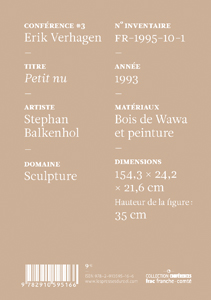The transcription of a lecture by Erik Verhagen on Stephan Balkenhol's Petit nu (1993).
Stephan Balkenhol makes serial objects. While questioning the history of sculpture, he maintains a close relationship with the material and plays on shifts in scale.
The figure of the
Petit nu (Little Nude) appears to be an outgrowth from a block or base. The woman perched atop this large parallelepiped appears as a small, precious “object”. Carved directly into the body of the wood, she shows some polychrome traces, reminiscent of medieval statuary or expressionist sculpture. The overall “rough-hewn” effect reflects the desire to leave visible traces of the process of work and chisel marks. The lack of gesture or expressiveness in
Stephan Balkenhol's figures is not synonymous with an inability to communicate. For the artist, who is also interested in Egyptian statuary, an impassive face provides a foil to the figure's personality, accentuating it all the more.
Erik Verhagen is a lecturer in contemporary art history at the University of Valenciennes. He has published numerous essays and articles on art from the 1960s to the present and is a regular contributor to specialist periodicals including
Art Press,
Critique d'Art and
Les Cahiers du Musée National d'Art Moderne. In 2010 he was curator of the Jan Dibbets exhibition at the Musée d'Art Moderne de la Ville de Paris. He co-authored the
Stephan Balkenhol catalogue, published in 2010 on the occasion of the artist's first major solo exhibition in France which ran until January 23, 2011 at the Musée de Grenoble.
German artist Stephan Balkenhol (born 1957 in Fritzlar, lives and works between Karlsruhe, Germany, and Meisenthal, France) has been producing polychrome wooden sculptures since the 1980's human or animal figures, sometimes hybrid, men and women of today in simple poses, standing statues or portrait busts. By choosing to carve wood like an artisan and to bring forth realistic-looking figures, Balkenhol breaks with a certain tradition of abstract and minimal contemporary sculpture, and takes up a place apart in the current art scene.








